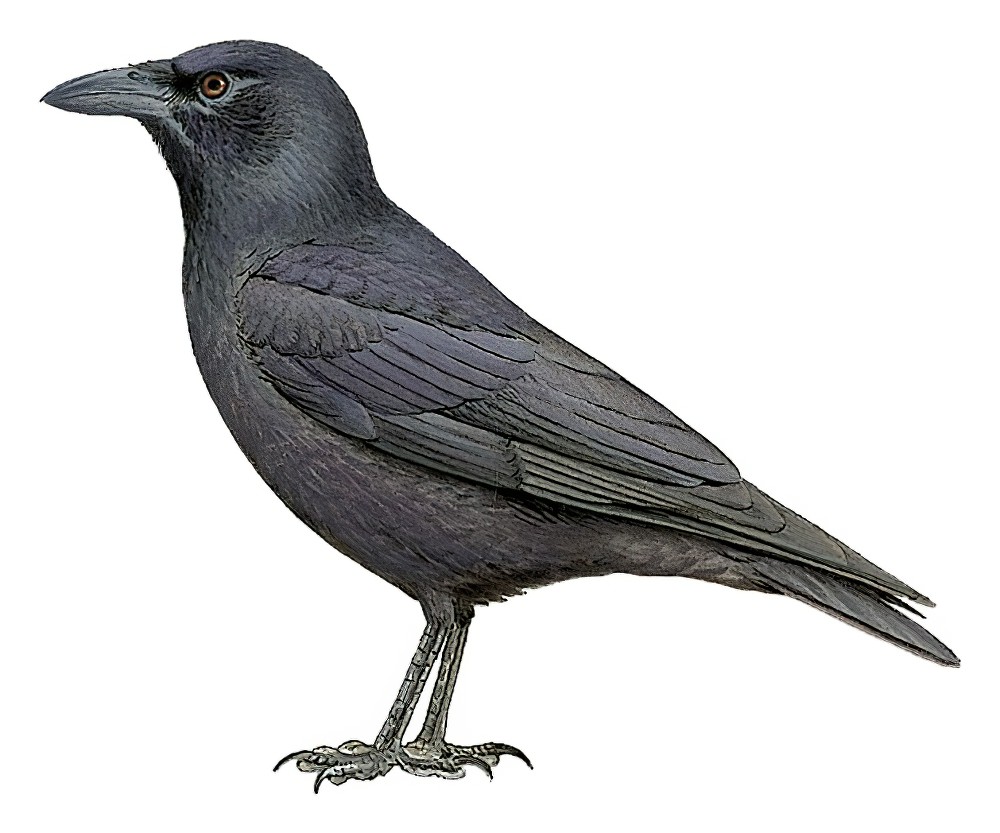Jamaican Crow / Corvus jamaicensis

Jamaican Crow
SCI Name:
Protonym: Corvus jamaicensis Syst.Nat. 1 pt1 p.367
Taxonomy: Passeriformes / Corvidae / Corvus
Taxonomy Code: jamcro1
Type Locality: Jamaica.
Author: Gmelin, JF
Publish Year: 1788
IUCN Status: Near Threatened
DEFINITIONS
CORVUS
(Corvidae; Ϯ Common Raven C. corax) L. corvus raven. In fable the Raven was originally white but, despite its supposed gift of prophecy, was turned into a black bird for its treachery. The Common or Northern Raven is the largest species of passerine bird; "48. CORVUS. Rostrum convexum, cultratum, basi pennis setaceis tectum. Lingua cartilaginea bifida." (Linnaeus 1758); "Corvus Linnaeus, 1758, Syst. Nat., ed. 10, 1, p. 105. Type, by tautonymy, "Corvus", i.e. Corvus corax Linnaeus." (Blake & Vaurie in Peters, 1962, XV, p. 261). This is the ninth diagnosed genus in avian taxonomy. Linnaeus's Corvus comprised twelve species (C. Corax, C. Corone, C. frugilegus, C. Cornix, C. Monedula, C. benghalensis, C. glandarius, C. cristatus, C. Caryocatactes, C. Pica, C. paradisi, C. infaustus).
Var. Cervus, Coruus.
Synon. Amblycorax, Anomalocorax, Archicorax, Coloeus, Corax, Corone, Corvultur, Frugilegus, Gymnocorax, Gymnocorvus, Heterocorax, Macrocorax, Microcorax, Monedula, Nesocorax, Palaeocorax, Physocorax, Pterocorax, Rhinocorax, Sitocorax, Trypanocorax.
corvus
L. corvus raven.
● From a local name Caa Maa crow gull, for the Black-legged Kittiwake in the Shetlands (syn. Rissa tridactyla).
jamaicensis
Jamaica (named Xaymaca land of springs, by the indigenous Taíno).
● ex “Cream-coloured Buzzard” of Latham 1781 (Buteo).
● ex “Chattering Crow” of Sloane 1725, and Latham 1781, “Cornix Jamaicensis” of Brisson 1760, and “Corneille de la Jamaïque” of de Buffon 1770-1783 (Corvus).
● ex “Least Water-Hen” of Edwards 1760 (Laterallus).
● ex “Columba minor ventre candido” of Sloane 1725, and “Pigeon de la Jamaïque” of Brisson 1760 (Leptotila).
● ex “Jamaica Night-Heron” of Latham 1785 (syn. Nyctanassa violacea).
● ex “Guira querea” of Ray 1713, “Wood-Owle” of Sloane 1725, “Mountain Owl” of Browne 1756, and “Jamaica Goatsucker” of Latham 1783 (Nyctibius).
● ex “Jamaica Shoveler” of Latham 1785 (Oxyura).
● TL. Coast of British Guiana; "Chalcophanes Wagl. 80. Ch. jamaicensis Cab. [nec Daudin] ... Lebt an der Küste und findet sich auf den Fahr- und Fusswegen, auf Grasplätzen, in der Umgebung der Coloniestadt, besucht auch häufig in kleineren Gesellschaften die Höfe der Wohnungen." (Cabanis 1849) (syn. Quiscalus lugubris).
● "*Holoquiscalus niger crassirostris (Swainson).1 ... 1 Ridgway and Peters have adopted for this form the subspecific name jamaicensis of Daudin (Traité Elém. Compl. Orn., 2, p. 317, 1800), a procedure that appears to me hardly justifiable. Daudin based his name by no means exclusively on Brown's "Merops niger, iride sub-argentea" from Jamaica, but this is merely one of the references which he believed to pertain to one and the same bird, for which "plusieurs îles des Antilles, la Jamaïque et le Labrador" are given as habitat. The only specimens actually seen by Daudin, upon which the description of his Sturnus jamaicensis was probably based, are those sent to the Paris Museum by Maugé from Porto Rico and "St. Thomas" [= H. n. brachypterus]. I do not advocate, however, transferring Daudin's name to the Porto Rico form, and would rather consider it an unidentifiable mixtum compositum." (Hellmay 1937) (?syn. Quiscalus niger).
● ex “Jamaica Thrush” of Latham 1783 (Turdus).
UPPERCASE: current genus
Uppercase first letter: generic synonym
● and ● See: generic homonyms
lowercase: species and subspecies
●: early names, variants, mispellings
‡: extinct
†: type species
Gr.: ancient Greek
L.: Latin
<: derived from
syn: synonym of
/: separates historical and modern geographic names
ex: based on
TL: type locality
OD: original diagnosis (genus) or original description (species)












